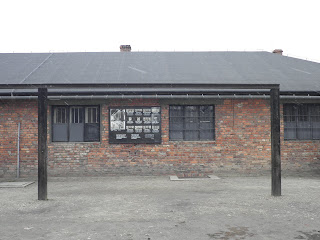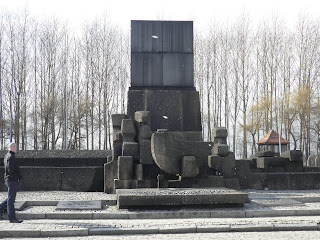Our trip to Oświęcim (Auschwitz) began in the morning of 3 Mar 2010 with a freelance guide called Bogdan, who also plays tenor saxophone in a local band (see Black A White) and a huge fan of Hard Rock / Heavy Metal music.
The trip to Auschwitz took about an hour and a half from Krakow. It is also not too difficult to make a trip there on your own as there are regular buses that go there (from the main bus terminal located behind Krakow Glowny train station).
We arrived at Auschwitz museum site at about 11.30 am and it was beginning to snow. There were also large groups of Jewish school children visiting the site. The entry to
The feeling around
The Death Wall was where prisoners were shot, sometimes at random. The death wall is located between blocks 10 and 11 (aka the ‘Death Block’). Block 11 consists of exhibits which described how prisoners were ‘prepared’ before they were killed.
The ‘standing cell’ was one of the worst torture methods used by the Nazis. After working for 10 long hours during the day, prisoners were hauled and made to stand (usually in a group of four people) in a very small block of about 1m x 1m x 1m during the night and prevented from proper rest and sleep. Most prisoners died of starvation and exhaustion.
The collective gallows
Apart from being shot and hanged, many prisoners were also gassed to death. Prisoners were tricked into believing that they will be led to a showering facility but instead deadly gas chambers await their fate. Dead prisoners were mass-cremated in one of the many crematoria within the concentration camp. By the time I left the crematoria, it was snowing cats and dogs.Just beside the crematoria in Auschwitz 1 is the Camp Gestapo where prisoners were interrogated. This was the site where the first commandant of the camp, Rudolph Hoss was tried and hanged.
Birkenau camp
After visiting Auschwitz1, Bogdan drove us to Birkenau, also known as Auschwitz II. Birkenau was where most of the killings took place and the camp was so much larger that I thought.
A monument was erected at Birkenau as a reminder of the atrocities committed by the Nazis.
The Nazis destroyed most of the gas chambers and prison blocks before they left. Here’s a snapshot of what was formerly a gas chamber.
After finished visiting Birkenau, we headed back to Krakow and visited the site which used to be the factory of Oskar Schindler (from the 1994 Speilberg movie Schindler’s List). Schindler ‘employed’ Jews to work in his factory to prevent them from being sent to Auschwitz and he is hailed as a hero by the Jewish people.

The visit to Auschwitz had been both physically and mentally draining and we decided to take a rest and simply chill out with a simple dinner and some Polish beer at the hotel restaurant.








No comments:
Post a Comment